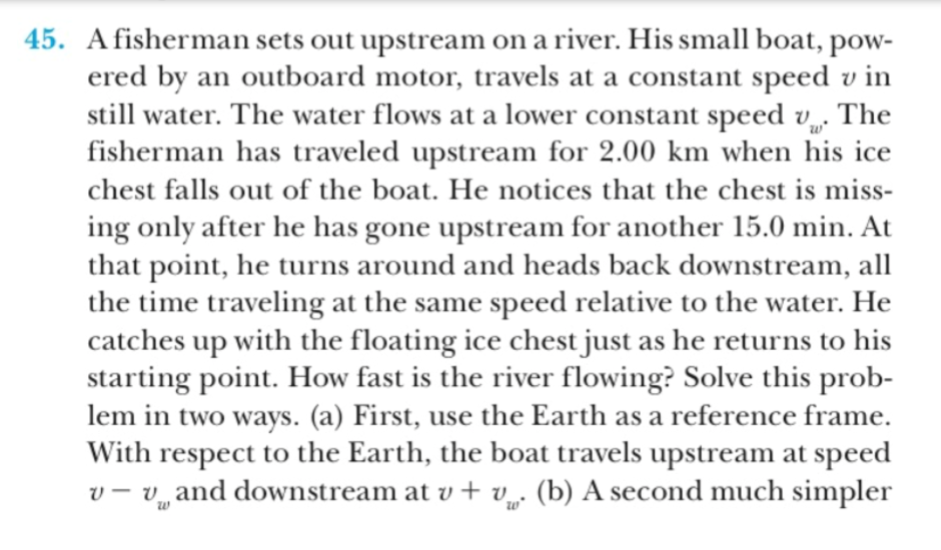45. Afisherman sets out upstream on a river. His small boat, pow ered by still water. The water flows at a lower constant speed v. The fisherman has traveled upstream for 2.00 km when his ice chest falls out of the boat. He notices that the chest is miss an outboard motor, travels at a constant speed v in ing only after he has gone upstream for another 15.0 min. At that point, he turns around and heads back downstream, all the time traveling at the same speed relative to the water. He catches up with the floating ice chest just as he returns to his starting point. How fast is the river flowing? Solve this prob- lem in two ways. (a) First, use the Earth as a reference frame With respect to the Earth, the boat travels upstream at speed v- and downstream at v + v (b) A second much simpler and more elegant solution is obtained by using the water as the reference frame. This approach has important applica- tions in many more culating the motion of rockets and satellites and analyzing the scattering of subatomic particles from massive targets complicated problems; examples are cal
45. Afisherman sets out upstream on a river. His small boat, pow ered by still water. The water flows at a lower constant speed v. The fisherman has traveled upstream for 2.00 km when his ice chest falls out of the boat. He notices that the chest is miss an outboard motor, travels at a constant speed v in ing only after he has gone upstream for another 15.0 min. At that point, he turns around and heads back downstream, all the time traveling at the same speed relative to the water. He catches up with the floating ice chest just as he returns to his starting point. How fast is the river flowing? Solve this prob- lem in two ways. (a) First, use the Earth as a reference frame With respect to the Earth, the boat travels upstream at speed v- and downstream at v + v (b) A second much simpler and more elegant solution is obtained by using the water as the reference frame. This approach has important applica- tions in many more culating the motion of rockets and satellites and analyzing the scattering of subatomic particles from massive targets complicated problems; examples are cal
Principles of Physics: A Calculus-Based Text
5th Edition
ISBN:9781133104261
Author:Raymond A. Serway, John W. Jewett
Publisher:Raymond A. Serway, John W. Jewett
Chapter3: Motion In Two Dimensions
Section: Chapter Questions
Problem 61P
Related questions
Question

Transcribed Image Text:45. Afisherman sets out upstream on a river. His small boat, pow
ered by
still water. The water flows at a lower constant speed v. The
fisherman has traveled upstream for 2.00 km when his ice
chest falls out of the boat. He notices that the chest is miss
an outboard motor, travels at a constant speed v in
ing only after he has gone upstream for another 15.0 min. At
that point, he turns around and heads back downstream, all
the time traveling at the same speed relative to the water. He
catches up with the floating ice chest just as he returns to his
starting point. How fast is the river flowing? Solve this prob-
lem in two ways. (a) First, use the Earth as a reference frame
With respect to the Earth, the boat travels upstream at speed
v- and downstream at v + v (b) A second much simpler

Transcribed Image Text:and more elegant solution is obtained by using the water as
the reference frame. This approach has important applica-
tions in many more
culating the motion of rockets and satellites and analyzing
the scattering of subatomic particles from massive targets
complicated problems; examples are cal
Expert Solution
This question has been solved!
Explore an expertly crafted, step-by-step solution for a thorough understanding of key concepts.
This is a popular solution!
Trending now
This is a popular solution!
Step by step
Solved in 6 steps with 5 images

Recommended textbooks for you

Principles of Physics: A Calculus-Based Text
Physics
ISBN:
9781133104261
Author:
Raymond A. Serway, John W. Jewett
Publisher:
Cengage Learning

Physics for Scientists and Engineers with Modern …
Physics
ISBN:
9781337553292
Author:
Raymond A. Serway, John W. Jewett
Publisher:
Cengage Learning

Physics for Scientists and Engineers
Physics
ISBN:
9781337553278
Author:
Raymond A. Serway, John W. Jewett
Publisher:
Cengage Learning

Principles of Physics: A Calculus-Based Text
Physics
ISBN:
9781133104261
Author:
Raymond A. Serway, John W. Jewett
Publisher:
Cengage Learning

Physics for Scientists and Engineers with Modern …
Physics
ISBN:
9781337553292
Author:
Raymond A. Serway, John W. Jewett
Publisher:
Cengage Learning

Physics for Scientists and Engineers
Physics
ISBN:
9781337553278
Author:
Raymond A. Serway, John W. Jewett
Publisher:
Cengage Learning

Classical Dynamics of Particles and Systems
Physics
ISBN:
9780534408961
Author:
Stephen T. Thornton, Jerry B. Marion
Publisher:
Cengage Learning

Physics for Scientists and Engineers: Foundations…
Physics
ISBN:
9781133939146
Author:
Katz, Debora M.
Publisher:
Cengage Learning

Physics for Scientists and Engineers, Technology …
Physics
ISBN:
9781305116399
Author:
Raymond A. Serway, John W. Jewett
Publisher:
Cengage Learning